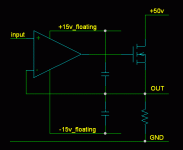Lets say we have a source follower driven by an opamp as per the diagram. Normally the power supply rails of the opamp are referenced to earth so if we want the follower output to swing 40v then the opamp output stage must (neglecting fet threshold voltage) swing the full 40v plus say 1 volt extra because the gate-source voltage must increase that 1volt to turn the fet on harder.
In this circuit though - and I may just be re-inventing the wheel here - the ps rails of the opamp are referenced to the fet drain and as a result the only voltage the opamp output has to swing is the 1 volt necessary to turn the fet on harder. The bottom of the opamp is effectively bootstrapped by the main output voltage.
The voltage swing and the slew rate requirements of the opamp are greatly reduced. In fact the effective operating range of the circuit is not limited by the opamp at all unless the gate is driven to +15 volts by the opamp and this is still not enough to make the fet pull the load up. That of course means you have other problems.
Normally using an opamp to drive amplifier output devices is a big no-no but in this cct, seeing so llittle is demanded of it, maybe it would have a better chance of working well, using the entire opamp gain to linearise the output stage. 😱
Has anyone else ever tried this cct?
GP.
In this circuit though - and I may just be re-inventing the wheel here - the ps rails of the opamp are referenced to the fet drain and as a result the only voltage the opamp output has to swing is the 1 volt necessary to turn the fet on harder. The bottom of the opamp is effectively bootstrapped by the main output voltage.
The voltage swing and the slew rate requirements of the opamp are greatly reduced. In fact the effective operating range of the circuit is not limited by the opamp at all unless the gate is driven to +15 volts by the opamp and this is still not enough to make the fet pull the load up. That of course means you have other problems.
Normally using an opamp to drive amplifier output devices is a big no-no but in this cct, seeing so llittle is demanded of it, maybe it would have a better chance of working well, using the entire opamp gain to linearise the output stage. 😱
Has anyone else ever tried this cct?
GP.
Attachments
Audio Amateur had some articles by William Chatter that were this way. Denon made some receivers like this in the mid 80s (BJT). Velleman offers a kit like this.
GP
The following articles may be of interest to you:
"Bootstrapping your op amp yields wide voltage swings"
at http://www.e-insite.net/ednmag/
"Extending op amp supplies to get more output voltage"
Linear Technology Application Note 67 pages 58 & 59
Geoff
The following articles may be of interest to you:
"Bootstrapping your op amp yields wide voltage swings"
at http://www.e-insite.net/ednmag/
"Extending op amp supplies to get more output voltage"
Linear Technology Application Note 67 pages 58 & 59
Geoff
Bootstraped OP AMP
The Audio Analog Puccini uses that tecnology but with bipolars darlingtons in the output stage...you can see it at...
http://www.pi.infn.it/~federico/puccini.htm
Regards
Jorge
The Audio Analog Puccini uses that tecnology but with bipolars darlingtons in the output stage...you can see it at...
http://www.pi.infn.it/~federico/puccini.htm
Regards
Jorge
I would want to see some protection to keep the input to the op amp between the rails. Some op amps have this built in, in which case you only need a current-limiting resistor on the input.
- Status
- Not open for further replies.
